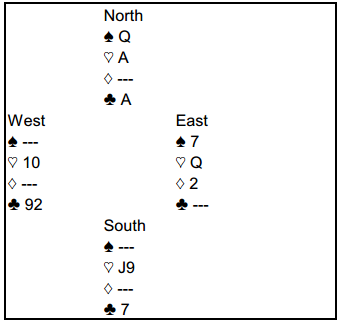Source: http://info.ecatsbridge.com
I started to play seriously in 1967, at the Summer North American Championships in Montreal, my home town. As I had less than 100 master points I could not play in the Life Master Pairs, the Spingold, or the Master Mixed Teams. However, my lifelong friend George Mittelman and I made our mark (or so we thought) in the secondary events, one day scoring over 225 on a 156 top in two separate single-session side games. Okay, so it wasn’t the big time, but we were barely 20 years old and unbelievably keen, and I still remember hurrying over to the major events to kibitz the great players of the day, hoping some of their wisdom would rub off on us. Although I confess that today I don’t hurry quite as much, my interest in seeking the truth about the game still keeps me coming back for more.
Four years later, most of my friends and I believed we had become pretty good players, and we had all enjoyed some success at the national and North American level. At the 1971 Can-Am Regional, I was playing with my great and good friend Joey Silver, who had taken me under his wing a couple of years earlier, ostensibly to play set “needle matches” for coin of the realm against his unsuspecting rubber bridge cronies.
The Can-Am was our most important local tournament, and as there were far fewer events at each tournament in those days, winning one of them was still a special achievement. Joey and I were playing in the Open Pairs and faring quite well at the table but less well away from it, as we were following a slow pair and never seemed to have more than ten minutes per round to play two deals. As luck would have it, on one of these “short” rounds the first board took most of the available time, and when we extracted our cards for the second deal there were only a couple of minutes left to play. These were the cards (directions altered):
Dlr: East Vul: Both
We bid quickly but with notable efficiency to 6NT, a particularly promising contract at matchpoints and one that seems destined to succeed when we look at all the cards. However, in my haste to catch up I took the lead of the  J with the queen and played on spades without cashing either a high club or a high heart in dummy, either of which would have produced a positive result. (Let us not mention the absence of a plan to counter the possibility of being tucked in dummy on the third or fourth round of spades.) East took the third spade and played a second diamond, which I won with the ace, discarding dummy’s
J with the queen and played on spades without cashing either a high club or a high heart in dummy, either of which would have produced a positive result. (Let us not mention the absence of a plan to counter the possibility of being tucked in dummy on the third or fourth round of spades.) East took the third spade and played a second diamond, which I won with the ace, discarding dummy’s  3, staking the fate of the deal on the club suit. As East was marked with eleven cards in spades and diamonds, West was an enormous favourite to hold the
3, staking the fate of the deal on the club suit. As East was marked with eleven cards in spades and diamonds, West was an enormous favourite to hold the  J, so I stifled a giggle at my carelessness and confidently led a club to the ten and jack, at which point I could not prevent myself from laughing rather more loudly.
J, so I stifled a giggle at my carelessness and confidently led a club to the ten and jack, at which point I could not prevent myself from laughing rather more loudly.
East thought it was pretty funny too and demonstrated his joy at being given an unexpected entry by loudly thumbing each of his five remaining high diamonds onto the table as the Director hovered over us. As you may already have foreseen, my greatest moment in bridge was not yet complete. As East led his last diamond, we were down to a three-card ending:

I knew that East held another spade, but was his remaining card a heart or a club? Perhaps trying to justify my club play to an extent only a masochist could appreciate, I decided to play East for a second club and so discarded the !A from dummy. East’s delight in showing me the  Q came as no surprise.
Q came as no surprise.
And so it came to pass that the young and (I confess) somewhat arrogant Eric O Kokish, aspiring to be one of Canada’s greatest players, finished minus 600 in a slam that was cold…umm…without a finesse… It occurred to me that I might have a future in the game when I was able to report the deal to the Daily Bulletin (perhaps only moments ahead of the thundering hordes, it’s true) with a smile on my face, despite the gaping wound in my heart. We did not win the 1971 Can-Am Open Pairs.
Although I can’t confirm with confidence that this incident convinced me not to take myself so seriously, it certainly contributed mightily. Years later, my Australian mate Bobby Richman pointed out that “we’re all little error machines” with an unlimited capacity to make them, batteries not included. Appreciating that makes it so much easier to deal with our inadequacies.
I still look forward to the next major tournament because there’s sure to be something new and interesting that I haven’t experienced before— places to go, people to see—something special worth keeping. Knowing that there will be high moments more than makes up for the inevitable disappointments.
Esta entrada también está disponible en: Spanish

